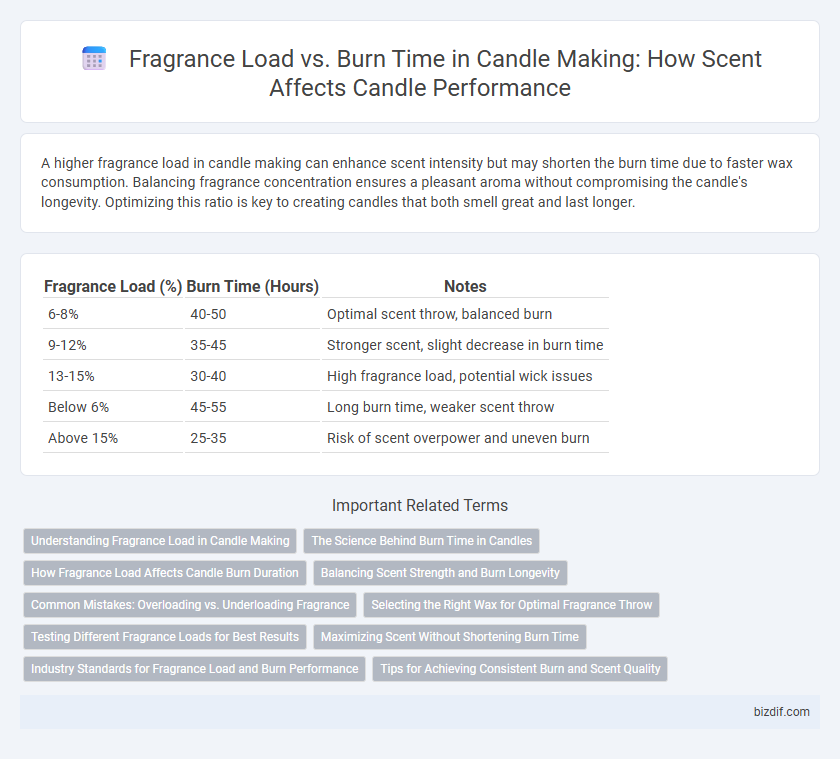A higher fragrance load in candle making can enhance scent intensity but may shorten the burn time due to faster wax consumption. Balancing fragrance concentration ensures a pleasant aroma without compromising the candle's longevity. Optimizing this ratio is key to creating candles that both smell great and last longer.
Table of Comparison
| Fragrance Load (%) | Burn Time (Hours) | Notes |
|---|---|---|
| 6-8% | 40-50 | Optimal scent throw, balanced burn |
| 9-12% | 35-45 | Stronger scent, slight decrease in burn time |
| 13-15% | 30-40 | High fragrance load, potential wick issues |
| Below 6% | 45-55 | Long burn time, weaker scent throw |
| Above 15% | 25-35 | Risk of scent overpower and uneven burn |
Understanding Fragrance Load in Candle Making
Fragrance load in candle making refers to the percentage of fragrance oils mixed into the wax, directly affecting the candle's scent throw and burn performance. Higher fragrance loads typically enhance the aroma strength but can shorten burn time or cause poor candle burning if exceeding the wax's fragrance retention limits, usually between 6% to 12%. Properly balancing fragrance load ensures an optimal combination of scent intensity and consistent burn time, crucial for creating quality candles.
The Science Behind Burn Time in Candles
Fragrance load in candle making directly impacts burn time by altering the wax's melting properties and combustion efficiency. Higher fragrance loads can cause candles to burn unevenly or faster due to changes in wax viscosity and increased soot production. Understanding the chemical interactions between fragrance oils and wax types optimizes burn time, ensuring a balanced release of scent and consistent flame performance.
How Fragrance Load Affects Candle Burn Duration
Higher fragrance load in candle wax can significantly influence burn time by altering the wax's melting point and combustion rate. Candles with excessive fragrance oils may burn faster due to softer wax structure, resulting in shorter burn durations despite stronger scent throw. Optimal fragrance load balances scent strength with consistent burn performance, ensuring candles maintain both fragrance intensity and desired burn longevity.
Balancing Scent Strength and Burn Longevity
Optimizing fragrance load in candle making is crucial for balancing scent strength and burn longevity, as higher fragrance percentages can enhance aroma but may reduce burn time due to faster wax consumption. Most candle makers recommend a fragrance load between 6% and 10% to achieve a strong, pleasant scent without compromising the candle's overall lifespan. Careful testing of wax types and fragrance oils ensures an ideal blend that delivers both a lasting fragrance experience and a consistent, safe burn.
Common Mistakes: Overloading vs. Underloading Fragrance
Overloading fragrance in candle making often leads to poor burn quality, including excessive soot and uneven melting, as the wax cannot properly bind the high concentration of oils. Underloading fragrance results in weak scent throw, diminishing the candle's aromatic appeal despite longer burn times. Balancing fragrance load, typically between 6% and 10%, ensures optimal scent diffusion and consistent burn performance.
Selecting the Right Wax for Optimal Fragrance Throw
Choosing the right wax significantly influences both fragrance load and burn time in candle making. Soy wax typically allows a higher fragrance load, ranging from 6% to 10%, enhancing scent throw without compromising burn duration. Beeswax, while offering a longer burn time due to its density, usually supports a lower fragrance load, making it ideal for subtle, long-lasting aromas.
Testing Different Fragrance Loads for Best Results
Testing different fragrance loads in candle making is essential to balance scent strength and burn time, as higher fragrance loads can enhance aroma but may reduce the candle's burning efficiency. Optimal fragrance load usually ranges between 6-10%, depending on wax type and candle size, ensuring a clean burn while delivering desired scent throw. Careful experimentation with small test batches helps identify the ideal fragrance percentage that maximizes scent without compromising burn quality.
Maximizing Scent Without Shortening Burn Time
Optimizing fragrance load in candle making enhances scent throw while preserving burn time by balancing fragrance oils within recommended limits, typically 6-10% of the wax weight. Exceeding the optimum fragrance load risks incomplete wax curing and excessive soot, leading to shorter and uneven burns. Using high-quality fragrance oils and proper wax types ensures a long-lasting, strong scent without compromising the candle's burn duration.
Industry Standards for Fragrance Load and Burn Performance
Industry standards for fragrance load in candle making typically range between 6% and 10% to balance scent intensity with optimal burn performance. Exceeding these standards can lead to issues such as excessive soot, uneven burning, and shortened burn time, as the wax struggles to burn cleanly with higher fragrance concentrations. Maintaining fragrance load within recommended limits ensures consistent scent throw while promoting a longer, safer burn duration.
Tips for Achieving Consistent Burn and Scent Quality
Maintaining an optimal fragrance load, typically between 6-10%, ensures a balanced scent throw without compromising the candle's burn time. Using a properly sized wick prevents tunneling and promotes even melting, improving both burn consistency and fragrance dispersal. Testing various fragrance oil brands and formulations helps identify those that maintain scent integrity throughout the candle's lifespan.
Fragrance Load vs Burn Time Infographic

 bizdif.com
bizdif.com